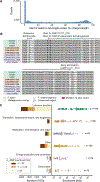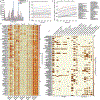Discovery of antimicrobial peptides in the global microbiome with machine learning
- PMID: 38843834
- PMCID: PMC11666328
- DOI: 10.1016/j.cell.2024.05.013
Discovery of antimicrobial peptides in the global microbiome with machine learning
Abstract
Novel antibiotics are urgently needed to combat the antibiotic-resistance crisis. We present a machine-learning-based approach to predict antimicrobial peptides (AMPs) within the global microbiome and leverage a vast dataset of 63,410 metagenomes and 87,920 prokaryotic genomes from environmental and host-associated habitats to create the AMPSphere, a comprehensive catalog comprising 863,498 non-redundant peptides, few of which match existing databases. AMPSphere provides insights into the evolutionary origins of peptides, including by duplication or gene truncation of longer sequences, and we observed that AMP production varies by habitat. To validate our predictions, we synthesized and tested 100 AMPs against clinically relevant drug-resistant pathogens and human gut commensals both in vitro and in vivo. A total of 79 peptides were active, with 63 targeting pathogens. These active AMPs exhibited antibacterial activity by disrupting bacterial membranes. In conclusion, our approach identified nearly one million prokaryotic AMP sequences, an open-access resource for antibiotic discovery.
Keywords: antibiotic discovery; antibiotic resistance; antimicrobial activity; antimicrobial peptides; global microbiome; machine learning; metagenomics.
Copyright © 2024 The Authors. Published by Elsevier Inc. All rights reserved.
Conflict of interest statement
Declaration of interests C.F.-N. provides consulting services to Invaio Sciences and is a member of the Scientific Advisory Boards of Nowture S.L. and Phare Bio. The de la Fuente Lab has received research funding or in-kind donations from United Therapeutics, Strata Manufacturing PJSC, and Procter & Gamble, none of which were used in support of this work. An invention disclosure associated with this work has been submitted.
Figures







Update of
-
Computational exploration of the global microbiome for antibiotic discovery.bioRxiv [Preprint]. 2023 Sep 11:2023.08.31.555663. doi: 10.1101/2023.08.31.555663. bioRxiv. 2023. Update in: Cell. 2024 Jul 11;187(14):3761-3778.e16. doi: 10.1016/j.cell.2024.05.013. PMID: 37693522 Free PMC article. Updated. Preprint.
Comment in
-
Machine learning identifies AMPs.Nat Rev Drug Discov. 2024 Aug;23(8):581. doi: 10.1038/d41573-024-00111-6. Nat Rev Drug Discov. 2024. PMID: 38937616 No abstract available.
References
-
- Porto WF, Irazazabal L, Alves ESF, Ribeiro SM, Matos CO, Pires ÁS, Fensterseifer ICM, Miranda VJ, Haney EF, Humblot V, et al. (2018). In silico optimization of a guava antimicrobial peptide enables combinatorial exploration for peptide design. Nat Commun 9, 1490. 10.1038/s41467-018-03746-3. - DOI - PMC - PubMed
MeSH terms
Substances
Grants and funding
LinkOut - more resources
Full Text Sources

